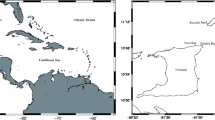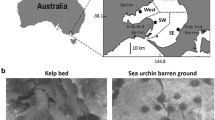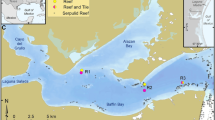Abstract
I sampled recruitment of very small sea urchins (Strongylocentrotus spp.) by using the anesthetic magnesium chloride to remove individuals from substrata collected in sea-urchin barren grounds (barrens) and kelp beds at Naples Reef near Santa Barbara, California, USA. Preliminary sampling found low numbers of newly settled individuals(<0.6 mm test diam) from April–July in 1984 and 1985, and in April, 1986. In early May, 1986, I found many newly settled seaurchins (0.3 to 0.6 mm, 5 to 17 d old), and I compared the densities of the cohort on several types of natural substrata in barrens and kelp-bed habitats. Newly settled individuals of both purple sea urchins (S. purpuratus) and red sea urchins (S. franciscanus) were present in similar, high densities (1 000 S. purpuratus m-2) on foliose red algal turf, a dominant substratum ofthe kelp bed, and on crustose coralline algae, the dominant substratum of an adjacent barrens. Larvae of S. purpuratus reared and tested in the laboratory showed high rates of settlement on both red algal turf and on crustose coralline algae, but significantly lower rates on rock. Larvae also settled in response to a partiallypurified extract of coralline algae. The reduced settlement on natural rock surfaces relative to either algal treatment and the significant settlement in response to the extract of coralline algae indicate that larvae discriminate between natural substrata and probably respond to a settlement cue other than, or in addition to, a simple microbial (bacterial) film. The similar densities of young recruits of S. purpuratus on dominant substrata of barrens and kelp bed show that, at least in this case, differential settlement cannot explain the high densities of sea urchins in the barrens habitat. Movement between barrens and kelp bed is unlikely given the small sizes of the newly recruited sea urchins relative to the large distances often involved. Reduced post-settlement mortality of newly settled individuals in the barrens remains the most likely mechanism leading to the higher densities of sea urchins in barrens relative to kelp-bed habitats.
Similar content being viewed by others
Literature cited
Andrew, N. L., Choat, J. H. (1982). The influence of predation and conspecific adults on the abundance of juvenile Evechinus chloroticus (Echinoidea: Echinometridae). Oecologia 54: 80–87
Andrew, N. L., Choat, J. H. (1985). Habitat related differences in the survivorship and growth of juvenile sea urchins. Mar. Ecol. Prog. Ser. 27: 155–161
Baker, R. J., Nelder, J. A. (1978). The GLIM system. Release 3. Numerical Algorithms Group, Oxford
Barker, M. F. (1977). Observations on the settlement of the brachiolaria larvae of Stichaster australis and Coscinasterias calamaria in the laboratory and on the shore. J. exp. mar. Biol. Ecol. 30: 95–108
Barker, M. F. (1979). Breeding and recruitment in a population of the New Zealand starfish Stichaster australis (Verill). J. exp. mar. Biol. Ecol. 41: 195–211
Bernstein, B. B., Jung, N. (1979). Selective pressures and coevolution in a kelp canopy community in southern California. Ecol. Monogr. 49: 335–355
Berstein, B. B., Williams, B. E., Mann, K. H. (1981). The role of behavioral responses to predators in modifying urchins' (Strongylocentrootus droebachiensis) destructive grazing and seasonal foraging patterns. Mar. Biol. 63: 39–49
Bray, R. N. (1981). Influence of water currents and zooplankton densities on daily foraging movements of blacksmith, Chromis punctipinnis, a planktivorous reef fish. Fish. Bull. U.S. 78: 829–841
Breitburg, D. L. (1984). Residual effects of grazing: inhibition of competitor recruitment by encrusting coralline algae. Ecology 65: 1136–1143
Cameron, R. A., Hinegardner, R. (1974). Initiation of metamorphosis in laboratory-cultured sea urchins. Biol. Bull. mar. biol. Lab., Woods Hole 146: 355–342
Cameron, R. A., Schroeter, S. C. (1980). Sea urchin recruitment: effect of substrate selection on juvenile distribution. Mar. Ecol. Prog. Ser. 2: 243–247
Chapman, A. R. O. (1981). Stability of sea urchin dominated barren grounds following destructive grazing of kelp in St. Margaret's Bay, castern Canada. Mar. Biol. 62: 307–311
Chia, F. S., Young, C. M., McEuen, F. S. (1984). The role of larval settlement behavior in controlling patterns of abundance in echinoderms. In: Engels, W. (ed.) Advances in invertebrate reproduction, Vol. 3. Elsevier, New York, p. 409–424
Connell, J. H. (1975). Some mechanisms producing structure in natural communities; a model and evidence from field experiments. In: Cody, M. L., Diamond, J. M. (eds.) Ecology and evolution of communities. Belknap Press, Cambridge, p. 460–490
Connell, J. H. (1985). The consequences of variation in initial settlement vs. post-settlement mortality in rocky intertidal communities. J. exp. mar. Biol. Ecol. 93: 11–45
Cowen, R. K. (1983). The effect of sheephead (Semicossyphus pulcher) predation on red sea urchin (Strongylocentrotus franciscanus) populations: an experimental analysis. Oecologia 58: 249–255
Dayton, P. K. (1985). Ecology of kelp communities. A. Rev. Ecol. Syst. 16: 215–245
Dayton, P. K., Tegner, M. J. (1984). The importance of scale in community ecology: a kelp forest example with terrestrial analogs. In: Price, P. W., Slobodchikoff, C. N., Gaud, W. S. (eds.) A new ecology: novel approaches to interactive systems. Wiley, New York, p. 457–481
Dean, T. A., Schroeter, S. C., Dixon, J. D. (1984). Effects of grazing by two species of sea urchins (Strongylocentrotus franciscanus and Lytechinus anamesus) on recruitment and survival of two species of kelp (Macrocystis pyrifera and Pterygophora califonica). Mar. Biol. 78: 301–313
Ebeling, A. W., Larson, R. J., Alevizon, W. S. (1980a). Habitat groups and island-mainland distribution of kelp-bed fishes off Santa Barbara, California. In: Power, D. M. (ed.) Multidisciplinary Symposium on the California Islands. Santa Barbara Museum of Natural History, Santa Barbara, California, USA, p. 403–431
Ebeling, A. W., Larson, R. J., Alevizon, W. S., Bray, R. N. (1980b). Annual variability of reef fish assemblages in kelp forests off Santa Barbara, California. Fish. Bull. U.S. 78: 361–377
Ebeling, A. W., Laur, D. R., Rowley, R. J. (1985). Severe storm disturbances and reversal of community structure in a southern California kelp forest. Mar. Biol. 84: 287–294
Ebeling, A. W., Laur, D. R., Rowley, R. J. (1988). Severe storms, sea urchins, and disturbance-driven kelp forests. (Abstracts and reports from the symposium/workshop on the marine environment of Santa Barbara and its coastal waters, held January 6, 1988, in Santa Barbara.) NOAA natn. mar. Fish. Serv. tech. Memo. U.S. Dep. Commerce (Mar. estuar. Mgmt div.)
Ebert, T. A. (1967). Negative growth and longevity in the purple sea urchin Strongylocentrotus purpuratus. Science N.Y. 157: 557–558
Ebert, T. A. (1968). Growth rates of the sea urchin (Strongylocentrotus purpuratus) related to food availability and spine abrasion. Ecology 49: 1075–1091
Ebert, T. A. (1975). Growth and mortality of post-larvalechinoids. Am. Zool. 15: 755–775
Ebert, T. A. (1982). Longevity, life history, and relative body wall size in sea urchins. Ecol. Monogr. 52: 535–394
Ebert, T. A. (1983). Recruitment in echinoderms. In: Jangoux, M., Lawrence, J. M. (eds.) Echinoderm studies, Vol. I. Balkema, Rotterdam, p. 169–203
Ebert, T. A., Russell, M. P. (1988). Latitudinal variation in size structure of the west coast purple sea urchin: a correlation with headlands. Limnol. Oceanogr. 33: 286–294
Emlet, R. B., McEdward, L. R., Strathmann, R. R. (1987). Echinoderm larval ecology viewed from the egg. In: Jangoux, M., Lawrence, J. M. (eds.) Echinoderm studies, Vol. 2. Balkema, Rotterdam, p. 55–136
Estes, J. A., Harrold, C. (1988). Sea otters, sea urchins, and kelp beds: some questions of scale. In: VanBlaricom, G. R., Estes, J. A. (eds.) The community ecology of sea otters. Springer-Verlag, New York, p. 116–150
Foster, M. S., Schiel, D. R. (1985). The ecology of giant kelp forests in California: a community profile. U.S. Fish Wildl. Serv. biol. Rep. 85 (7.2): 1–153
Gaines, S., Roughgarden, J. (1985). Larval settlement rate: a leading determinant of structure in an ecological community of the marine intertidal zone. Proc. natn. Acad. Sci. U.S.A. 82: 3707–3711
Harrold, C., Reed, D. C. (1985). Food availability, sea urchin grazing, and kelp forest community structure. Ecology 66: 1160–1169
Highsmith, R. C. (1982). Induced settlement and metamorphosis of sand dollar (Dendraster excentricus) larvae in predator-free sites: adult sand dollar beds. Ecology 63: 329–337
Himmelman, J. H., Lavergne, Y., Axelsen, F., Cardinal, A., Bourget, E. (1983). Sea urchins in the Saint Lawrence Estuary: their abundance, size-structure, and suitability for commercial exploitation. Can. J. Fish. aquat. Sciences 40: 474–486
Hinegardner, R. T. (1969). Growth and development of the laboratory-cultured sea urchin. Biol. Bull. mar. biol. Lab., Woods Hole 137: 465–475
Jackson, G. A., Winant, C. D. (1983). Effect of a kelp forest on coastal current. Contin. Shelf Res. 2: 75–80
Keough, M. J., Downes, B. J. (1982). Recruitment of marine invertebrates: the role of active larval choices and early mortality. Oecologia 54: 348–352
Lang, C., Mann, K. H. (1976). Changes in sea urchin populations after the destruction of kelp beds. Mar. Biol. 36: 321–326
Laur, D. R., Ebeling, A. W. (1983). Predator-prey relationships in surfperches. Envir. Biol. Fish. 8: 217–229
Laur, D. R., Ebeling, A. W., Coon, D. A. (1988). Effects of sea otter foraging on subtidal reef communities off central California. In: VanBlaricom, G. R., Estes, J. A. (eds.) The community ecology of sea otters. Springer-Verlag, New York, p. 150–168
Lawrence, J. M. (1975). On the relationships between marine plants and seaweeds. Oceanogr. mar. Biol. A. Rev. 13: 213–286
Leahy, P. S. (1986). Laboratory culture of Strongylocentrotus purpuratus adults, embryos and larvae. In: Schroeder, T. E. (ed.) Methods in cell biology. Vol. 27. Academic Press, Orlando, p. 1–13
Luckenbach, M. W. (1984). Settlement and early post-settlement survival in the recruitment of Mulinia lateralis (Bivalvia). Mar. Ecol. Prog. Ser. 17: 245–250
McPherson, B. F. (1965). Contributions to the biology of the sea urchin Tripneustes ventricosus. Bull. mar. Sci. 15: 228–244
Menge, B. A., Sutherland, J. P. (1976). Species diversity gradients: synthesis of the roles of predation, competition and temporal heterogeneity. Am. Nat. 110: 351–369
Menge, B. A., Sutherland, J. P. (1987). Community regulation: variation in disturbance, competition, and predation in relation to environmental stress and recruitment. Am. Nat. 130: 730–757
Mitchell, R., Kirchman, D. (1984). The microbial ecology of marine surfaces. In: Costlow, J. D., Tipper, R. C. (eds.) Marine biodeterioration; an interdisciplinary study. Naval Institute Press, Annapolis, p. 49–56
Morse, A. N. C., Froyd, C. A., Morse, D. E. (1984). Molecules from cyanobacteria and red algae that induce larval settlement and metamorphosis in the mollusc Haliotis rufescens. Mar. Biol. 81: 293–298
Morse, D. E., Hooker, N., Duncan, H., Jensen, L. (1979). Gammaaminobutyric acid, a neurotransmitter, induces planktonic abalone larvae to settle and begin metamorphosis. Science, N.Y. 204: 407–410
Neter, J., Wasserman, W. (1974). Applied linear statistical models. R. O. Irwin, Inc., Homewood, Illinois
Paine, R. T. (1977). Controlled manipulations in the marine intertidal zone, and their contributions to ecological theory. Spec. Publs Acad. nat. Sci. Philad. 12: 245–270
Paine, R. T. (1980). Food webs: linkage, interaction strength and community infrastructure. J. Anim. Ecol. 49: 667–685
Paine, R. T. (1980). Ecological determinism in the competition for space. Ecology 65: 1339–1348
Pearse, J. S., Clark, M. E., Leighton, D. L., Mitchell, C. T., North, W. J. (1970). Marine waste disposal and sea urchin ecology. A. Rep. W. M. Keck Lab. envrl Hlth Engng, Calif. Inst. Technol. Kelp Habit Improvement Project 1969–1970: 1–89
Pearse, J. S., Hines, A. H. (1987). Long-term population dynamics of sea urchins in a central California kelp forest: rare recruitment and rapid decline. Mar. Ecol. Prog. Ser. 39: 275–283
Raymond, B. G., Scheibling, R. E. (1987). Recruitment and growth of the sea urchin Strongylocentrotus droebachiensis (Müller) following mass mortalities off Nova Scotia, Canada. J. exp. mar. Biol. Ecol. 108: 31–54
Roughgarden, J., Iwasa, Y., Baxter, C. (1985). Demographic theory for an open marine population with space-limited recruitment. Ecology 66: 54–67
Schiel, D. R., Foster, M. S. (1986). The structure of subtidal algal stands in temperate waters. Oceanogr. mar. Biol. A. Rev. 24: 265–307
Shepherd, S. A., Turner, J. A. (1985). Studies on southern Australian abalone (genus Haliotis). VI. habitat preference, abundance and predators of juveniles. J. exp. mar. Biol. Ecol. 93: 285–298
Sokal, R. R., Rohlf, F. J. (1981). Biometry. The principles and practice of statistics in biological research. 2nd ed. W. H. Freeman & Co., San Francisco
Swan, E. F. (1958). Growth and variation in sea urchins of York, Marine, J. mar. Res. 17: 505–522
Swan, E. F. (1961). Some observations on the growth rate of sea urchins in the genus Strongylocentrotus. Biol. Bull. mar. biol. Lab., Woods Hole 120: 420–427
Tegner, M. J., Dayton, P. K. (1977). Sea urchin recruitment patterns and implications of commercial fishing. Science, N.Y. 196: 324–326
Tegner, M. J., Dayton, P. K. (1981). Population structure, recruitment and mortality of two sea urchins (Strongylocentrotus franciscanus and S. purpuratus) in a kelp forest. Mar. Ecol. Prog. Ser. 5: 255–268
Trapido-Rosenthal, H. G., Morse, D. E. (1986). Regulation of receptor-mediated settlement and metamorphosis in larvae of a gastropod mollusc (Haliotis rufescens). Bull. mar. Sci. 39: 383–392
Underwood, A. J., Denley, E. J. (1984). Paradigms, explanations, and generalizations in models for the structure of intertidal communities on rocky shores. In: Strong, D. R., Simberloff, D., Abele, L. G., Thistle, A. B. (eds.) Ecological communities: conceptual issues and the evidence. Princeton University Press, Princeton, p. 151–180
Victor, B. (1986). Larval settlement and juvenile mortality in a recruitment-limited coral reef fish population. Ecol. Monogr. 156: 145–160
Wethey, D. S. (1985). Local and regional variation in settlement in the littoral barnacle Semibalanus balanoides (L.): patterns and consequences. In: Moore, P. G., Seed, R. (eds.) The ecology of rocky coasts. Hodder and Stoughton, Toronto, p. 194–202
Woodin, S. A. (1985). Effects of defecation by arenicolid polychaete adults on spionid polychaete juveniles in field experiments: selective settlement or differential mortality. J. exp. mar. Biol. Ecol. 87: 119–132
Woodin, S. A. (1986). Settlement of infauna: larval choice?. Bull. mar. Sci. 39: 401–407
Yool, A. J., Grau, S. M., Hadfield, M. G., Jensen, R. A., Markell, D. A., Morse, D. E. (1986). Excess potassium induces larval metamorphosis in four marine invertebrate species. Biol. Bull. mar. biol. Lab., Woods Hole 170: 255–266
Young, C. M., Chia, F.-S. (1982). Factors controlling spatial distribution of the sea cucumber Psolus chitinoides: settling and postsettling behavior. Mar. Biol. 69: 195–205
Author information
Authors and Affiliations
Additional information
Communicated by J. M. Lawrence, Tampa
Communicated by J. Mauchline, Oban
Rights and permissions
About this article
Cite this article
Rowley, R.J. Settlement and recruitment of sea urchins (Strongylocentrotus spp.) in a sea-urchin barren ground and a kelp bed: are populations regulated by settlement or post-settlement processes?. Mar. Biol. 100, 485–494 (1989). https://doi.org/10.1007/BF00394825
Accepted:
Issue Date:
DOI: https://doi.org/10.1007/BF00394825




